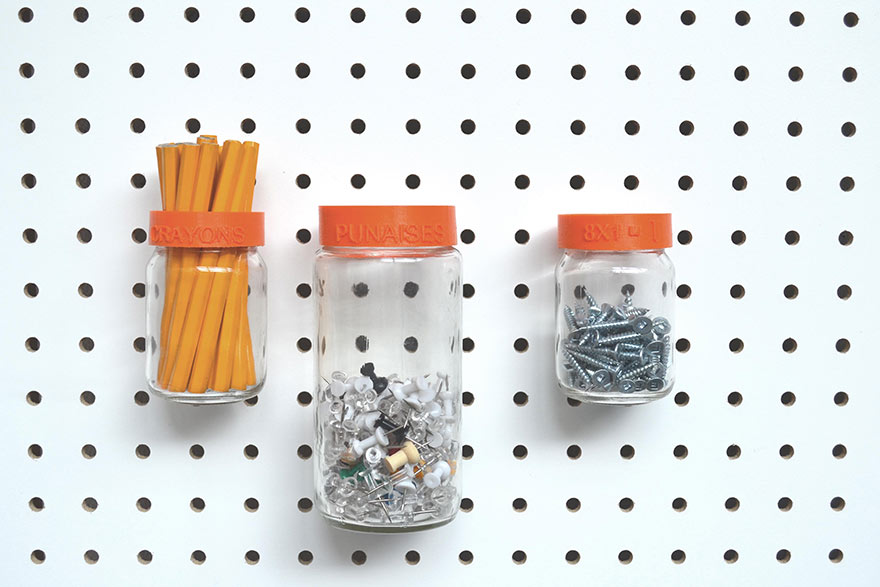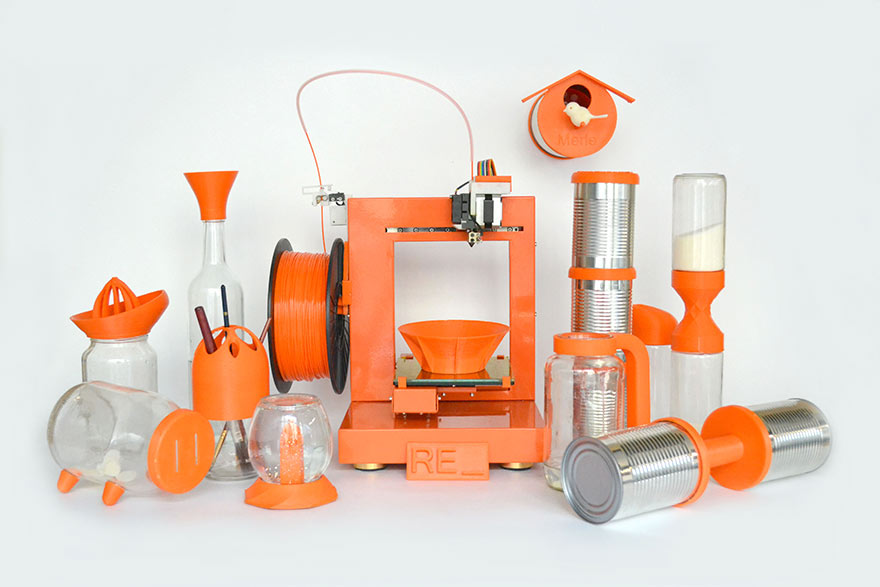Designer Sam Bernier’s starting point is the ultimate contemporary dilemna. “After finishing the content of a mason jar… I always clean it and keep it for later use. I quickly realised that I had almost no opportunities to actually reuse them unless I decided to turn my kitchen into a canning manufacture,” he writes. Bernier’s response was to create customised lids using low cost 3D printing for the jars. He uses the popular phrase ‘upcycling’.
The phrase upcycling is a strangely moralistic term. Rather than an object being re-used in any old fashion – old ceramics crushed into powder and used as supplement to cement for example – up-cycling suggests an act of improvement on the original, and an improvement enacted by a human being who makes something better by ingenuity. Surely in the absolute terms of an environmentalist any kind of re-use is worthwhile. Indeed as recycling is possible on an industrial scale and therefore truly beneficial. Upcycling then is more of a design term or a craft term. It is the urban equivalent of beach-combing – there is something more exciting going on here.
According to Bernier, the Project RE_ is an act of ‘upcycling’. I’d say that it offers something a bit more interesting than that. Much more interesting in fact. It is the best expression yet of 3D printing as an example of what Clayton M. Christensen described as ‘disruptive technology.’ Christensen later changed his term to the now more popular term ‘disruptive innovation’ because he felt that what he described initially as the way in a which technologies change initial business models was often simply the new application of an existing technology. Christensen was market focused underestimated the relationship between technology and society or certainly those technologies which are not immediately mediated by business. Indeed the hacker world which Bernier’s work emerges from suggests that ‘disruption’ itself is becoming a self-identified social status.
The most exciting aspect about 3D printing has always been the way it decentralised the site of production. Only a few people such as Assa Ashuach have imagined what that could mean on a grand scale . Many of the current projects in 3D printing Bernier’s fascinating project included are based at the domestic scale. Here is what the individual can do to provide for their individual needs. But Bernier’s project is intriguing because it imagines the possibility of endlessly disruptive technology. A technology which can continually re-think the objects around it. If we take what Ashuach and others have imagined about the contemporary scale of the project.
What is interesting about Bernier’s work is that the potential scale and the versatility of the technology lies latent in his work. The lids are then clipped or screwed onto standard jars, tin cans and bottles to create new and personal objects. Huge numbers of iterations are easy to achieve as his Instructables page shows. He made 14 objects in his first collection : a watering can, an hour glass, a long pasta container, a bird house, a bird feeder, a mug, a rain catcher, a maple syrup bottle, a piggy bank, a orange juicer, a snow globe, a paint brush cleaner, a dumb-bell and a lamp. The ones that want to get a juicer can look into the best juicers in Australia and see the best option for them.

The most exciting aspect about 3D printing has always been the way it decentralised the site of production. Only a few people such as Assa Ashuach have imagined what that could mean on a grand scale . Many of the current projects in 3D printing Bernier’s fascinating project included are based at the domestic scale. Here is what the individual can do to provide for their individual needs. But Bernier’s project is intriguing because it imagines the possibility of endlessly disruptive technology. A technology which can continually re-think the objects around it. If we takewhat Ashuach and others have imagined about the contemporary scale of the project What is interesting about Bernier’s work is that the potential scale and the versatility of the technology lies latent in his work. The lids are then clipped or screwed onto standard jars, tin cans and bottles to create new and personal objects. Huge numbers of iterations are easy to achieve as his Instructables page shows. He made 14 objects in his first collection : a watering can, an hour glass, a long pasta container, a bird house, a bird feeder, a mug, a rain catcher, a maple syrup bottle, a piggy bank, a orange juicer, a snow globe, a paint brush cleaner, a dumb-bell and a lamp.











